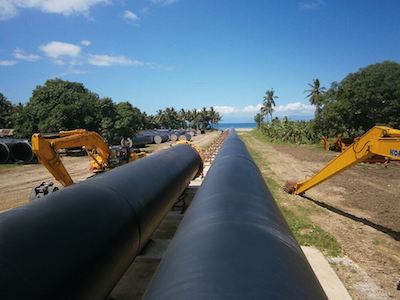Plastics Pipe Institute issues advisory for substandard plastic pipe use in oil and gas fields
Unmarked HDPE pipe being used to transport oil and gas in the Permian and Delaware basins in Texas and New Mexico could prematurely fail if not manufactured to relevant standards.
September 5, 2018

The Plastics Pipe Institute, Inc. (PPI) has issued a warning about substandard high-density polyethylene (HDPE) pipe that does not comply with relevant product standards, which has been found in the oil and gas gathering operations of the Permian and Delaware basins in Texas and New Mexico.
These pipelines are not marked with relevant product standard requirements, and may not comply with those product standards. Pipe that is not properly marked or certified provides no assurance of product quality and may not perform as intended for the application. The notice extends to other areas where HDPE pipe is widely used such as potable water, forced main sewers, industrial, and mining applications. PPI is the major North American plastic pipe trade association with many of its member companies producing resins, pipe, fittings, and components.
|
The Plastics Pipe Institute recommends that pipe purchasers should review the pipe manufacturer's certification reports along with physical plant inspections or independent third-party validation and testing. |
PI warns about HDPE pipe that does not comply with relevant product standards and recommends that purchasers review the pipe manufacturer's certification reports along with physical plant inspections or independent third-party validation and testing.
"We're issuing this advisory because we are seeing HDPE pipes that have significant quality issues," stated Tony Radoszewski, CAE, president of PPI. "In some cases neither the manufacturer nor the origin of the pipe could be identified. Unfortunately, due to the quickly rising demand for HDPE pipe we're seeing an influx of pipe that does not meet industry standards. Properly marked HDPE pipe will be imprinted to identify specific standards, and to help confirm that the pipe is suitable for its intended purpose. But this cannot be relied upon by itself as a printline is no guarantee of the quality of the pipe. There are other end-user validation points such as Certificates of Quality from the manufacturer, on-site inspections of the plant, and an array of short-term physical property and mechanical tests and measurements on produced pipe to verify pipe quality.
"Pipe manufacturers can participate in the quality systems established in the industry. This starts with a TR-4 listing in the Plastics Pipe Institute Hydrostatic Stress Board Program plus unannounced random audits conducted by a certifying body.
"Pipe not in compliance could jeopardize the safety of employees, the public and the environment. Piping products should be inspected upon delivery to ensure they meet the appropriate standards and the operator’s specifications. This is especially critical for projects in demanding oil and gas field operations, and is also important for pipe used in other pressure applications such as water, sewer, industrial, and mining applications.”
The association also recommends that purchasers review the pipe manufacturer's certification reports along with physical plant inspections or independent third-party validation and testing.
"There is time, effort and labor needed to develop the standards and to produce product that will meet those standards," Radoszewski stated. "Not all HDPE pipe is created equally. Know what resin is being used in the manufacture of the pipe. Know what company is making the pipe. Know what company is selling the pipe. There is a considerable investment for the resin manufacturer and the pipe manufacturer to produce high-performance products. There is a cost for quality because of the steps required from the manufacturing of the plastic resin to the extrusion of the pipe in order to produce a product that meets industry standards and regulations. But the benefits definitely outweigh the extra cost. No one wants a catastrophic pipeline failure caused by substandard pipe."
About the Author(s)
You May Also Like





